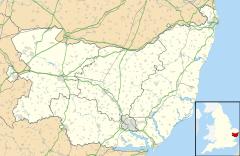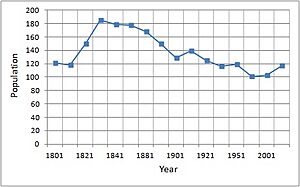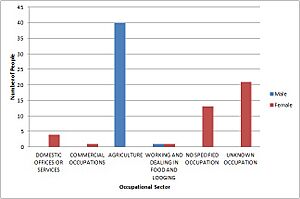Flowton facts for kids
Quick facts for kids Flowton |
|
|---|---|
 Church of St Mary |
|
| Population | 117 (2011 Census) |
| OS grid reference | TM082468 |
| Civil parish |
|
| District | |
| Shire county | |
| Region | |
| Country | England |
| Sovereign state | United Kingdom |
| Post town | Ipswich |
| Postcode district | IP8 |
| Dialling code | 01473 |
| Police | Suffolk |
| Fire | Suffolk |
| Ambulance | East of England |
| EU Parliament | East of England |
| UK Parliament |
|
Flowton is a small village in Suffolk, England. It is located in the Mid Suffolk area. About 117 people live there. The name 'Flowton' comes from an old word, 'Flocctun'. This word means a place where sheep are kept, or a sheep farm.
The village is about six miles northwest of Ipswich. Ipswich is the main town in Suffolk. Flowton has a small area called Flowton Brook. The village is mostly farmland. You can see scattered farmhouses and some newer homes. These are often near the local church, St Mary's.
Contents
St Mary's Church: A Historic Building
Flowton's church, known as St Mary's, is very old. It was built in the 13th century. This means it has been a place of worship for about 700 years! The church holds many events to raise money. People from the village and nearby areas help support it.
St Mary's Church is a special building. It is listed as a Grade I building. This means it is very important historically. It is made of flint stone with special stone decorations. The church has a main hall (nave) and a chancel. It also has a south porch and a west tower.
You can see old carvings on the stone buttresses. These are called mass dials. They used to show villagers when church services would start. Over the years, the church has changed. A new room, called a vestry, was added around the late 1700s. People think this room was once used as a school for village children.
John Charlesworth was a vicar here from 1815 to 1844. He was an important Christian leader. He also worked to end slavery.
Flowton Priory: A Moving House
Flowton Priory was a large house built in Flowton in 1525. It stayed in the village for 400 years. But in 1928, something amazing happened. Its owner decided to move it! The house was carefully taken apart, brick by brick. Then, it was rebuilt in Harpenden, Hertfordshire.
In 1994, a racing driver named David Pinkney bought the house. He said that when it was moved, every part was checked. Everything was made good again. It was also put on strong new foundations. Flowton Priory is now a Grade II listed building. It is a beautiful Tudor-style mansion.
Flowton's Population Changes Over Time
The number of people living in Flowton has changed a lot. Look at the graph of the population. Between 1831 and 1861, the population changed unevenly. The number of houses went up from 1831 to 1851. But the population actually went down during that time.
Later, in 1921, both the population and the number of houses decreased. Flowton's population grew quickly between 1811 and 1831. Then it stayed quite steady until 1851. This shows that the village was growing and developing. Both the population and the number of houses dropped in the early 1900s. The population did not really start to rise again until 2001.
Jobs and Work in Flowton
Old Jobs in Flowton
For a long time, most jobs in Flowton were in farming. Between 1500 and 1700, many people were farmers. They worked on the land. By the early 1800s, 37 people worked in farming. Only 3 people worked in shops.
By the mid-1800s, there were also bricklayers and millers. The graph shows that in 1881, farming was still the main job. Many women were listed as having no specific job. This often meant they worked at home. Or they helped with family businesses. The graph shows that women worked in more types of jobs than men back then. Most men worked only in farming.
Modern Jobs in Flowton
Farming is still a small part of Flowton's jobs today. But a lot has changed! Data from 2011 shows that people in Flowton have many different jobs. About one-third of the people worked in manual labor. This includes construction and mechanical work.
Men now work in many different job areas. In 1881, they mostly worked in two areas. But in 2011, they worked in nine different types of jobs. Many people in Flowton now work in public services. This includes health care, education, and office jobs. Women's jobs have also changed a lot since 1881. In 2011, women worked in many different industries. Some of these jobs, like farming or construction, were once mostly done by men.
Flowton Community Life
People in Flowton often hold events to raise money. The church is usually the main place for these events. Every year, the village has an "open garden" event. Visitors can walk around gardens that villagers open to the public.
At the same time, a flower festival happens inside the church. Both events last for two days. You can buy one ticket to visit both. The church also takes part in a bike ride event. This ride raises money for historic churches in Suffolk. The money helps keep the church in good condition.




